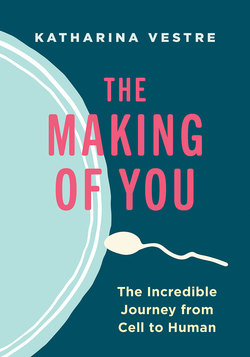Читать книгу The Making of You - Katharina Vestre - Страница 21
На сайте Литреса книга снята с продажи.
ОглавлениеAT THE START of the third week, the cell cluster which is soon to become you flattens and spreads out across the vesicle. Right now there’s nothing that even vaguely resembles a body – you look more like a little round plate. On each side of the plate are two fluid-filled sacs. One of them becomes the foetal sac, which will enclose you and the little pool in which you’ll live for the next few months. The other will become the yolk sac, a round balloon with its cord fastened inside your stomach. The yolk sac creates your first blood cells; a job that your liver, spleen and your bone marrow will eventually take over. When it’s no longer needed, the yolk sac will shrivel up and become part of your intestines.
With birds and other egg-laying animals, the most important role for the yolk sac is to provide nutrition – they have no placenta to feed on, of course – so it’s packed with vitamins, minerals, fats and proteins. If you crack open a hen’s egg, in addition to the yellow yolk sac you may also notice some thin white threads keeping the yolk attached to the centre of the egg. In a fertilised egg, a chick slowly emerges from a thin white plate on the surface of the sac. At first, it’s a barely visible speck, but after a few days red blood vessels coil themselves around the yolk. Soon after that, the yolk sac shrivels up and a living creature gradually emerges. Three weeks later the egg hatches and a new chick is ready to meet the world.
Things go a little bit slower for us humans. But at the start of the third week you take at least one important step forward from the plate stage. Over the course of a few crucial hours, you are given a front, a back, a top and bottom, and right and left sides. It’s one of the most critical periods in your whole development. Had something gone wrong, then you wouldn’t be reading this book now, with your intestines safely packed behind your skin and your heart beating reliably on the left side of your chest.
The first sign of this dramatic change is that the round plate becomes more of an oval shape. At the same time a thin strip appears. This is the beginning of your back, and it extends from the edge and towards the centre of the oval plate, where your head will pop up later on. If we were to zoom in on this strip, we’d see all the cells wandering down it towards a small pit at its centre. The cells dive into it, forming a new layer under the topmost one. Soon you will consist of two cell plates stacked one on top of the other. Shortly after that, new cells arrive and spread themselves between the two plates, so that you end up with three layers of cells.
This may not sound terribly impressive; I promised you dramatic changes, and all that’s happened is that a round plate has become a triple-decker cell sandwich. But you’re already infinitely more interesting than the raspberry you were a short while ago. These cells are no longer confused, needy newcomers with no idea where they are or what they’re supposed to do. They have completed a rough division of labour. The cells on the top layer will form, among other things, skin, hair, nails, eye lenses, nerves and your brain. From the bottom layer you’ll get intestines, liver, trachea and lungs. And the middle layer will become your bones, muscles, heart and blood vessels.
As time moves on, each cell will become more and more specialised. Eventually, you will end up with over 200 different types. Their shape, size and characteristics will vary enormously. Round red blood cells will float around your body, carrying oxygen. Immune cells will patrol for intruders. Your ear will contain hairy sensory cells that dance to every sound you hear, and electrical signals will flicker and spark in your brain through the long threads of nerve cells.
